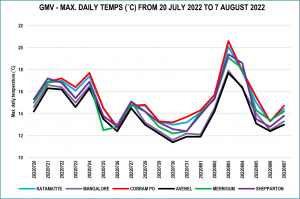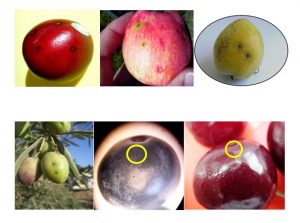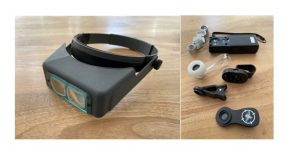This information has been commissioned by the Goulburn Murray Valley (GMV) Area Wide Management Fruit Fly Program and is funded by the Victorian Government. Use of this material in its complete and original format, acknowledging its source, is permitted, however unauthorised alterations to the text or content is not permitted.
Current trap captures
Few Queensland fruit fly were trapped on the Goulburn Murray Valley trapping grid through August due to the cold conditions. These flies were found predominantly in Shepparton and Grahamvale. As the weather warms up through spring, capture rates will continue to rise. This reflects the fact that temperatures were too cold for fruit fly to be responsive to traps through winter, however there may have been a reasonable number of adults that survived the winter by finding warm refuges.
Sites of concern – potential hot spots
Analyses of regional trapping data for spring 2021 and autumn 2022 showed that several locations recorded relatively high fruit fly populations at both times of the year. This suggests that fruit fly will be problematic in those areas in the coming season of 2022/2023. The areas of concern are:
- Orrvale
- Kyabram
- Merrigum
- Undera
- Grahamvale
- Shepparton
If you live in or near these locations, it is recommended you have monitoring traps out and you check any nearby ripening, ripe or overripe fruit within the vicinity for the presence of Queensland fruit fly. Regular monitoring by the beginning of September 2022 is advised.
The impact of weather on fruit fly
There is some variation in weather conditions between locations within the Goulburn Murray Valley with Avenel and Mangalore being cooler than Shepparton, Merrigum, Katamatite and Cobram.

Minimum temperatures varied from -3.4˚C at the Shepparton Airport on 20 July to 9.9˚C in Cobram Post Office and Yarroweyah on 4 August. There was considerable variation in daily minimum temperatures, too. Mangalore Airport registered 0.4˚C (i.e. 3.8˚C warmer than Shepparton Airport) on 20 July and Merrigum recorded a minimum of 7.9˚C (i.e. 2˚C cooler than Cobram Post Office).
Weather outlook
The Bureau of Meteorology outlook for the Goulburn Murray Valley in September 2022 (http://www.bom.gov.au/climate/outlooks/#/overview/summary/ suggests that there is a 65% to 75% chance of higher than average (25mm to 50mm) rainfall. There is a 50% to 60% chance that maximum daily temperatures will be above the average (15˚C to 21˚C) and a 65% to 75% chance that daily minimum temperatures will be higher than average (3˚C to 6˚C).
Queensland fruit fly outlook
Higher than usual rainfall, daily minimum temperatures and neutral maximum temperatures indicate highly favourable conditions for overwintering adult fruit fly to emerge from their winter refuges and find fruit to infest. A third consecutive La Niña event for late 2022 and early 2023 has been predicted. If this occurs following the favourable spring conditions forecast for fruit fly survival and proliferation, yet another bad fruit fly year is likely.
For the period from 20 July to 7 August 2022, it was estimated that dusk temperatures throughout the Goulburn Murray Valley were generally below the threshold for fruit fly to mate (about 15˚C to 16˚C at dusk) so mating was unlikely unless there were warmer microclimates and males were able find females. There was one day, however, during this period that dusk temperatures were estimated to be at the level that could allow fruit fly to mate and that was 3 August 2022 in all areas of the Goulburn Murray Valley tested except Mangalore and Avenel. This date was the first of more to follow as the weather has continued to warms up.
If Queensland fruit fly management programs and strategies are in place early in spring 2022 and followed throughout the season, fruit fly can be kept under control. The importance of whole-of-community ownership, awareness and participation cannot be understated.
Breaking the fruit fly life cycle in early spring
Fruit fly typically damages fruit and fruiting vegetables, such as capsicum and tomatoes, in the Goulburn Murray Valley in the summer and autumn but population build-up occurs from early spring as overwintering adults spread out from their winter refuges and infest fruit as the weather warms up. If this spring cohort of flies is controlled then later populations of fruit fly, that damage summer and autumn crops, will be reduced, resulting in more fruit fly free fruit. There are two approaches that can be taken to achieve this and it’s best to do both:
- Control springtime adults directly using baits, traps and, if necessary, approved pesticides
- Stop adults from infesting fruit by making sure there are no suitable fruit in the area (pick up and harvest unwanted fruit, remove fruiting plants before their fruit matures) or protect desired fruit using netting.
How to find early signs of fruit fly activity
Since 2012/13 Queensland fruit fly populations have popped up sporadically in the spring in different locations across the region. In some areas this occurs every year due to established resident populations. In other areas fruit fly populations build up later in the season or in some years but not others, due to low host fruit numbers and adverse localised weather conditions.
The ideal management strategy is to implement control measures before population build-up and the first step is to find out if (and when) Queensland fly are present. The earlier this can be achieved the more effective the control of Queensland fruit fly to result. Fruit fly management will be facilitated by implementing the following:
Look at ripening and ripe fruit – Infested spring time fruit is the first sign of fruit fly build-up. Just about any ripening, ripe or over-ripe fruit present in the spring is a potential target for fruit fly to infest. These fruit exist all across the landscape and it is beneficial to be aware of what they are and where they are.
• In the orchard – late hanging fruit, unharvested fruit, early season fruit
• In the backyard, sides of the house and front yard
• Fruiting street trees
• Fruiting weed plants in and around the property
• Along creek banks, roadsides
•In abandoned orchards
• Untended fruiting plants in rented properties and unoccupied land
• On Crown land and council land
If there are any fruit nearby, they can be examined for infestation:
• Check fruit surface for sting marks. These are marks caused by the fruit fly making a hole in the fruit surface (“stinging the fruit”) into which it lays its eggs. Sometimes the fruit reacts with a wound response causing browning or blackening around the oviposition site which is easily seen. Sting marks on oranges can re-green just around the oviposition site. Other fruit (blueberries, cherries, some white peach varieties) have sting holes but without a visible wound response.
Some sting holes do not have eggs in them. The fly may have tested the position but decided that she would not lay any eggs there. It might have been too exposed to sun or wind, or she might have been frightened off by a bird or chased off by a rival fly.
A jeweller’s loupe or other type of magnifier is a very convenient tool for fruit inspection.
• Check the fruit surface for soft areas. When Queensland fruit fly eggs are laid some bacteria are injected with the eggs. These break down fruit cells into mush which is then easily fed on by newly hatched fruit fly larvae. This causes fruit tissue around and underneath the oviposition holes to go soft. This can be detected by gentle thumb pressure.
Such bruising may be caused by other pests and diseases as well as rubbing on branches or other fruit.
• Check inside the fruit for infestation. If you find sting marks, holes or soft patches in fruit you should check that these were caused by fruit fly. This is done by cutting the fruit. Using a sharp blade cut a 4mm slice of fruit and skin across the fruit just under the sting mark, hole or soft patch. Lever this fruit flap off and turn it out to expose the flesh under the skin. A magnifier can be used to examine the flesh and skin for fruit fly eggs or larvae.
Eggs and newly hatched larvae are very small. Eggs are just 1mm long and newly hatched larvae are less than 2mm long. Eggs are a glistening pearly white but when hatched the remaining eggshell is translucent and white and flat like a burst balloon. Young larvae are translucent white, cream or partly coloured by the fruit’s colour. Four- to seven-day old larvae range from 2 to 8mm in length and are creamy white or partly coloured by the fruit.
Use fruit fly traps
Male-targeting traps
The most common fruit fly trap contains a pheromone-like attractant that only males respond to. Providing weather conditions are suitable these traps can attract male fruit fly from up to about 200m but if it’s cool or windy, as it often is during early spring, they are less effective at such distances.
The most effective springtime trap is one that is placed where fruit fly males are present. This location is very difficult to find. The most likely spot would be close to where large numbers of fruit fly were trapped during late autumn or where there was a sizable late autumn fruit infestation event. Other likely spots would be where early maturing fruit are ripening or where some unharvested or late-hanging fruit persist.
Place traps:
- Preferably in host trees. These can be heavy-canopied evergreens such as lemons where Queensland fruit fly overwinter or trees with ripening, ripe or overripe fruit.
- At 1.2m or higher in tall trees.
- Inside the canopy, protected from direct sun from at least 10am onwards. Late afternoon sun is OK if it’s less than about 32˚C.
- Away from branches, sticks and leaves so that ants don’t enter the traps and eat all the fruit fly in there.
- In positions where spray from sprayers don’t knock the trap off the tree or break it open.
Food-based traps
Several traps that are relatively new to the market attract both male and female Queensland fruit fly using food-based compounds such as broken-down yeast cells (yeast autolysate) and synthetic fruit aromas as attractants. These traps are effective at much smaller distances than the male traps and need to be very close to Queensland fruit fly locations (within 10 to 20m) to be useful for pest monitoring.
Food-based traps are best deployed in the same way as the male-targeting traps but need to be placed in the orchard entry pathway (part of the orchard perimeter closest to existing fruit fly populations) and in winter refuge plants especially evergreen plants located close to winter-heated areas (e.g. house, packing shed).
Food-based traps are very useful in that they can capture female Queensland fruit fly. In her lifetime (about 2 months in late spring to early autumn; much longer in the cooler weather) one mated female fly can lay nearly 2,000 eggs from which up to 800 adult flies can emerge.
Eradicating females early in the season will have a significant impact on subsequent fruit fly populations.
Areas with existing fruit populations
If Queensland fruit fly has been a problem each year for the past couple of years or more, it is likely they will be present again this year. Rather than wait for them to start breeding put baits out as early in September as you can. Fruit fly will return, so it’s best you attack them early. At this time of year there may be very few fruiting crops around, but baiting will stop fly populations building up to be a threat to later-maturing crops.
Bait orchard boundaries where orchards are bordered by urban blocks, especially in the larger towns such as Cobram, Shepparton, Kyabram, Mooroopna. Bait throughout the orchard if infestations were found in the orchard last season.
If traps are out and you are monitoring fruit manually and you find evidence of Queensland fruit fly start baiting immediately.
Sting marks

Sting marks can be easy to see: Top left (nectarine), top middle (apple), top right (loquat), middle left (olive) OR sting marks can be difficult to see: Middle (blueberry), middle right (cherry), bottom (pre-veraison wine grape cv ‘Chardonnay’)

Magnifiers and blades


Above: Jeweller’s loupe; right (top): Two types of handheld magnifiers; right (bottom): Four type of magnifiers that attach to a mobile phone.
Above: Something all horticulturists have in their possession at all times. Very useful when monitoring fruit for the presence of fruit flies.
Goulburn Murray Valley Area Wide Management Fruit Fly Program
For assistance in managing fruit fly, contact the Project Coordinator at the Goulburn Murray Valley Fruit Fly Office by phoning (03) 5871 9222 or email gmvfruitfly@moira.vic.gov.au.
This report was produced and supplied by Janren Consulting Pty Ltd for the purpose of the Goulburn Murray Valley Fruit Fly Program. The Goulburn Murray Valley Fruit Fly Area Wide Management Program is supported by the Victorian Government.
